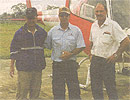Nelson based commercial helicopter pilot, Ricky Park returned to New Zealand last week from operations in Myanmar. Based near the China and Thailand borders in the country once known as Burma, and closely supported by Myanmar military intelligence, Ricky was flying US military personnel to suspected crash sites in an operation to recover and repatriate remains of WW2 airmen lost in the region.
One of two locally based pilots with Helicopters NZ Ltd and primarily involved with agricultural work, spraying, top dressing, animal poisoning, fire lighting, fire fighting and grass seeding, Ricky has also been involved in servicing offshore iron sand ships at Taharoa, near Kawhia Harbour.
"Servicing ships capable of carrying 120,000 tonnes of iron sand back to Japan. It includes transferring the harbour pilot aboard when it arrives within three miles of the shore, to put it on the buoy. Then we fly out stores, MAF inspectors, shipping agents, and fetching the pilot back off again when it finally sails. I did that from 1990 to 1995," Ricky explained.
During their least busy season and when pilots are required in South East Asia they head north. Last year he was working in Laos for the Joint Task Force - Full Accounting (JTF-FA) looking for pilots or remains of aircrew lost in the Vietnam War. Formed in 1992, the JTF-FA seeks the full accounting of all military personnel missing in action (MIA) in South East Asia. In 1975 there were 2,585 of them. Since 1992 the JTF-FA have performed a total of 146 missions, repatriating the positively identified remains of 567 personnel.
This year's month long expedition was to Myanmar, looking for Second World War crash sites.
Working on an American MIA mission, with the war in Iraq going on at the time meant security was tight. "We had the Myanmar military intelligence with us all the time," Ricky said, "we didn't fly anywhere without one of their guys on board with us, not necessarily on every flight but always one with us on the job. Then we had armed soldiers on the job itself and they camped out all the time. Specifically in Myitkyina and with the Americans we always - even going out for dinner in the evening, had military intelligence with us in the van."
They spent five weeks excavating a site but found nothing, and soon realised they were acting on misinformation, as 28 bodies had been removed during the war. "So in the last week we flew out to different villages asking questions to see if we could locate the correct site. There is not a lot of information available because it was such along time ago, not many witnesses remain," he explained. They were the sole transportation providers for a team of 16 Americans being flown in and out daily, using two AS350 Squirrel machines.
Helicopters NZ Ltd is a private New Zealand company founded in Timaru in 1955 which has operated continuously and internationally ever since. Operational control of the company, along with the offices of the chief executive officer, manager, group chief pilot, engineering manager, and chief engineer are located at No. 3 Hangar, Nelson Airport.
Subsidiary companies include Glacier Southern lakes Helicopters Ltd whose primary work is supporting the tourism industry on the West Coast, Queenstown and Twizel. Helicopters (Australia) Pty Ltd, Perth WA supports the mineral, mining and exploration industry, including the transfer of marine pilots and performing aeromagnetic surveys, while Lao Westcoast Helicopter Co. Vientiane, Loas, provides support to the American MIA Programme and also services the mineral and mining industry. And last year they had thirteen machines operating in Antarctica, where they have been performing operations since 1976.
Depending of contracts, approximately 55 pilots fly a fleet of 42 helicopters, with 26 of those the AS350 Squirrel range of aircraft. "It's really their size range," Ricky explained. "With a double front seat you can put seven people on board including the pilot which is used extensively for tourism type work. We try to limit it to 6 people onboard including the pilot for commercial work. The B model Squirrels, when in hot flying conditions like in South East Asia, can be limiting because the temperature and air density at altitude can overload the engine, so the tendency for the company is the BA model or better. The BA is more powerful with bigger blades so it will lift a load to a higher altitude. When you get into the B2 model you are really into the power, you can load it up with 6 people and full fuel and go anywhere you might need to."
Ricky started flying in 1972 as a private pilot with the Motueka Aero Club. Then after 15 years in his own business developing hill country with crawler tractors and bulldozers, he sold the business in 1985 and went for his commercial license. He began as a loader driver for a local pilot in Tapawera, and spent six years loading the Llama heavy lift helicopter in Nelson, and has since been commercial flying since 1990 and flown over 5,500 hours in helicopters.
On completion of his assignment Ricky and fellow colleagues then flew the two aircraft from Myitkyina in northern Myanmar, very close to the Chinese border, south to Yangon (Rangoon) a 5.3 hour flight, passing through Mandalay and Toungoo for fuel. They then flew out of Yangon across to Mae Sot in Thailand, down to Bangkok, refuelled and then across to Seim Reab and then to Phnom Penh, to fly home via Singapore on a commercial flight. The two AS350 helicopters are due back in Nelson soon aboard an American Hercules aircraft.
"It makes it exciting when you get away to countries like that," Ricky acknowledged but after a brief rest period he's happily straight back into it here, "I have spraying to do at Cable Bay, a fire lighting job out at Wangapeka, and then some grass seeding."

